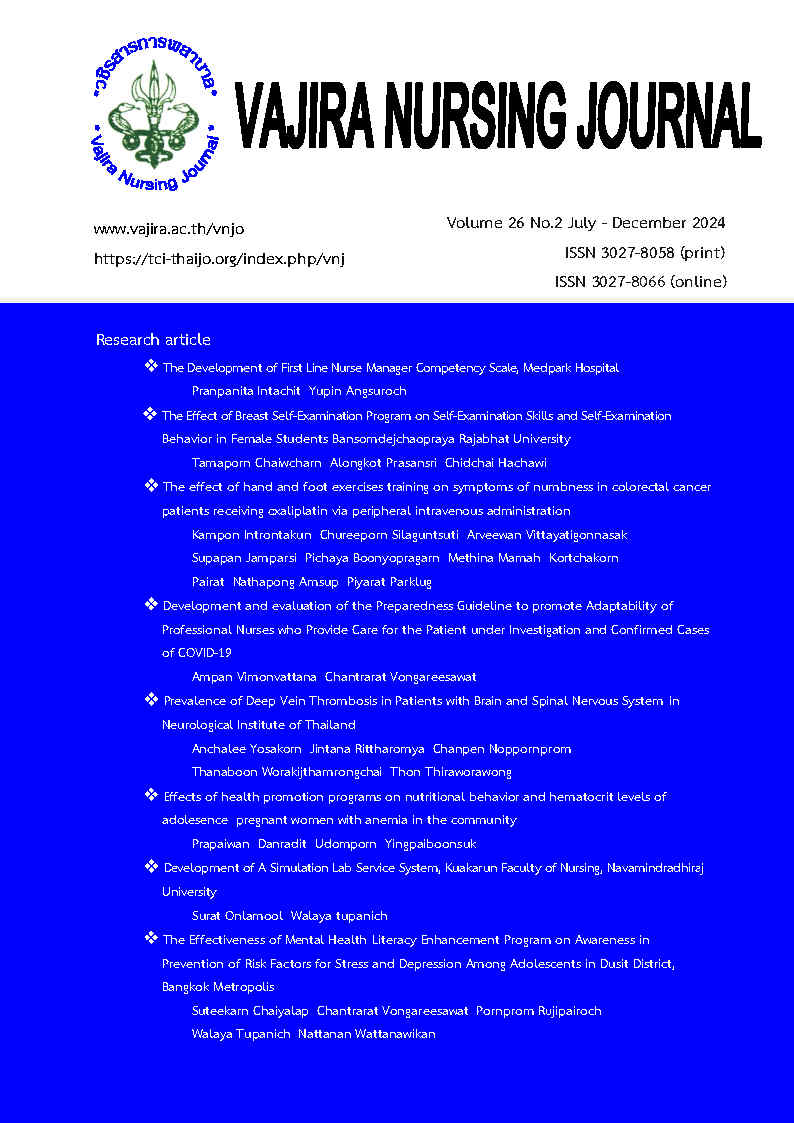การดูแลผู้ป่วยวิกฤตที่เกิดแผลผิวหนังอักเสบ จากการควบคุมการขับถ่ายไม่ได้: กรณีศึกษา
Main Article Content
บทคัดย่อ
แผลผิวหนังอักเสบจากการควบคุมการขับถ่ายไม่ได้ (Incontinence-associated dermatitis: IAD) เป็นสาเหตุที่นำไปสู่การเกิดแผลกดทับ และลดความสำเร็จของตัวชี้วัดที่สำคัญในหอผู้ป่วยวิกฤต บทความนี้มุ่งเน้นที่จะนำเสนอ 1) ปัจจัยเสี่ยงในการเกิดแผล IAD 2) กลไกการเกิดแผล IAD 3) เครื่องมือประเมินความเสี่ยงและเครื่องมือประเมินความรุนแรงของแผล IAD และ 4) การดูแลแผล IAD ตามระดับความรุนแรง โดยบูรณาการกรอบแนวคิดวงจรป้องกันและจัดการแผล IAD ลงสู่การปฏิบัติดูแลผู้ป่วยวิกฤตที่เกิดแผล IAD ขณะเข้ารับการรักษาในหอผู้ป่วยวิกฤต ผลการดูแล พบว่า การใช้กรอบแนวคิดวงจรป้องกันและจัดการแผล IAD ร่วมกับการใช้หลักฐานเชิงประจักษ์ในการดูแลแผล IAD สามารถลดความรุนแรง และส่งเสริมการหายของแผล IAD ได้อย่างมีประสิทธิภาพ
Article Details

อนุญาตภายใต้เงื่อนไข Creative Commons Attribution-NonCommercial-NoDerivatives 4.0 International License.
เนื้อหาและข้อมูลในบทความที่ลงตีพิมพ์ในวชิรสารการพยาบาลถือเป็นข้อคิดเห็นและความรับผิดชอบของผู้เขียนบทความโดยตรง ซึ่งกองบรรณาธิการไม่จำเป็นต้องเห็นด้วย หรือร่วมรับผิดชอบใด ๆ ทั้งสิ้น
บทความ ข้อมูล เนื้อหา รูปภาพ ฯลฯ ที่ได้รับการตีพิมพ์ในวชิรสารการพยาบาล ถือเป็นลิขสิทธิ์ของวชิรสารการพยาบาล หากบุคคลใดหรือหน่วยงานใดต้องการนำทั้งหมดหรือส่วนหนึ่งส่วนใดไปเผยแพร่ต่อหรือเพื่อกระทำการใด ๆ จะต้องได้รับอนุญาตเป็นลายลักอักษรจากวชิรสารการพยาบาลก่อนเท่านั้น
เอกสารอ้างอิง
United Nations Department of Economic and Social Affairs, Population Division. World Population Prospects 2022: Summary of Results. UN DESA/POP/.
Kayser SA, Koloms K, Murray A, Khawar W, Gray M. Incontinence and incontinence-associated dermatitis in acute care: A retrospective analysis of total cost of care and patient outcomes from the Premier Healthcare Database. JWOCN. 2021;48(6):545-52. doi: 10.1097/WON.0000000000000818.
Uppanisakorn S, Somma T, Vattanaprasan P, Boonyarat J. Prevention and treatment of incontinence-associated dermatitis (IAD) in critical patients treated in the intensive care unit of a medical ward. Thai J Nurs Coun. 2015;30(2):86-100. (in Thai)
Beeckman D. Incontinence-associated dermatitis (IAD) and pressure ulcers: an overview. In: Romanelli M, Clark M, Gefen A, Ciprandi G, editors. Science and practice of pressure ulcer management. 2nd ed. London, UK: Springer; 2018: 89–101.
Deprez J, Ohde N, Eilegård Wallin A, Bååth C, Hommel A, Hultin L, et al. Prognostic factors for the development of incontinence-associated dermatitis (IAD): A systematic review. Int Wound J. 2024;21(7). doi: 10.1111/iwj.14962.
da Silva Meirelles LC, da Rocha BP, Wammes AL, dos Santos DM, da Silva DM, de Souza LM. Incidence of incontinence-associated dermatitis among clinical inpatients. Rev Enferm UERJ. 2020;28: e51323. doi: 10.12957/ reuerj.2020.51323.
Wang G, Wang X, Wang H, Wang L, Li W. Risk factors for incontinence-associated dermatitis in critically ill patients with incontinence: A systematic review and meta-analysis. JWOCN. 2024;51(4):313-323. doi: 10.1097/WON.0000000000001090.
Cui Y, Zhou Y, Liu C, Mao Z, Zhou F. Interpretable machine learning models for predicting the incidence of antibiotic-associated diarrhea in elderly ICU patients. BMC Geriatrics. 2024;24(1): 458. doi: 10.1186/s12877-024-05028-8.
Banharak S, Panpanit L, Subindee S, Narongsanoi P, Sanun-Aur P, Kulwong W, et al. Prevention and care for incontinence-associated dermatitis among older adults: A systematic review. J Multidiscip Healthc. 2021; 2983-3004. doi: 10.2147/JMDH.S329672.
Nix DH. Validity and reliability of the Perineal Assessment Tool. Ostomy Wound Manage. 2002;48(2):43-46.
Junkin J. TargetingIncontinence – Associated Dermatitis: A Leading Risk Factor for Pressure Ulcers.In The 3rd Congress of the World Union of Wound Healing Societies; 4-8 June 2008.
Simimand S, Banharak S, editors. Measuring translation and psychometric testing of the Perineal Assessment Tool (PAT) and Incontinence-Associated Dermatitis Intervention Tool (IADIT) among patients in semi-intensive care units: A pilot study. Science, Technology, and Social Sciences Procedia. 2023;2023(3): NCCR03.
Wei HH, Huang C-L, Huang W-P, Chen H-C. Development of an incontinence-associated dermatitis prevention bundle using an evidence-based framework. World Counc Enterostomal Ther J. 2020;40(3):37-42. doi: 10.33235/wcet.40.3.37-42.
Beeckman D, Campbell J, Campbell K, Denise Chimentão D, Domansky R, Gray M, et al. Incontinence-associated dermatitis: Moving prevention forward. Wounds Int [Internet]. 2015 [cited 2024 Aug 15]. Available from www.woundsinternational.com.
Phungsiri P. The effect of utilizing work instruction for incontinence-associated dermatitis in high-risk patients. Reg 11 Med J. 2016;30(1):59-67. (in Thai)
Gunasegaran N, Ang SY, Ng YZ, Lee NES, Agus N, Lee CW, et al. The effectiveness of a hydrocolloid crusting method versus standard care in the treatment of incontinence-associated dermatitis among adult patients in an acute care setting: A randomized controlled trial. J Tissue Viability. 2023;32(2):171-178. doi: 10.1016/j.jtv.2023.01.007.
Beele H, Smet S, Van Damme N, Beeckman D. Incontinence-associated dermatitis: Pathogenesis, contributing factors, prevention, and management options. Drugs Aging. 2018;35:1-10. doi: 10.1007/s40266-017-0507-1.
LeBlanc K, Forest-Lalande L, Rajhathy E, Parsons L, Hill M, Kuhnke JL, et al. Best practice recommendations for the prevention and management of moisture-associated skin damage. Wound Care Canada [Internet]. 2020 [cited 2024 Aug 15]. Available from: www.woundscanada.ca/docman/public.


